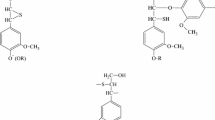Abstract
A new method to obtain cellulose sulfates from available and inexpensive raw material—aspen wood was developed. This method integrates catalytic peroxide delignification and sulfamic acid sulfation stages. Solvents such as acetic acid and water were used for isolation of pure cellulose by wood peroxide delignification with TiO2 catalyst. Low-aggressive and less-toxic sulfating agent—sulfamic acid–urea mixture was used to obtain cellulose sulfates.









Similar content being viewed by others
References
Al-Horani RA, Desai UR (2010) Chemical sulfation of small molecules—advances and challenges. Tetrahedron 66:2907–2918
ASTM D1795 (2013) Standard Test method for intrinsic viscosity of cellulose. ASTM International, West Conshohocken, PA, p 6
Chen G, Zhang B, Zhao J, Chen H (2013) Improved process for the production of cellulose sulfate using sulfuric acid/ethanol solution. Carbohyd Polym 95:332–337
Fengel D (1992) Characterization of cellulose by deconvoluting the OH valence range in FTIR spectra. Holzforschung 46:283–288
Fox SC, Li B, Xu D, Edgar KJ (2011) Regioselective esterification and etherification of cellulose: a review. Biomacromol 12:P 1956–1972
Gericke M, Liebert T, Heinze T (2009) Interaction of ionic liquids with polysaccharides, 8 - synthesis of cellulose sulfates suitable for polyelectrolyte complex formation. Macromol Biosci 9:343–353
Hu F, Jung S, Ragauskas A (2012) Pseudo-lignin formation and its impact on enzymatic hydrolysis. Bioresour Technol 117:7–12
Huang X, Zhang WD (2012) Preparation of cellulose sulfate and evaluation of its properties. J Fiber Bioeng Inf 3:32–39
Kuznetsov BN, Tarabanko VE, Kuznetsova SA (2008) New catalytic methods for obtaining cellulose and other chemical products from vegetable biomass. Kinet Catal 49:517–526
Kuznetsov BN, Sudakova IG, Garyntseva NV, Djakovitch L, Pinel C (2013) Kinetic study of aspen-wood sawdust delignification by H2O2 with sulfuric acid catalyst under the mild conditions. Reac Kinet Mech Cat 110:271–280
Kuznetsov BN, Kuznetsova SA, Levdansky VA, Levdansky AV, Vasil’eva NY, Chesnokov NV, Ivanchenko NM, Djakovitch L, Pinel C (2015) Optimized methods for obtaining cellulose and cellulose sulfates from birch wood. Wood Sci Technol 49:825–843
Lin N, Huang J, Dufresne A (2012) Preparation, properties and applications of polysaccharide nanocrystals in advanced functional nanomaterials: a review. Nanoscale 4:3274–3294
Nishiyama Y, Langan P, Chanzy H (2002) Crystal structure and hydrogen-bonding system in cellulose Iβ from synchrotron X-ray and neutron fiber diffraction. J Am Chem Soc 124:9074–9082
Pala H, Mota M, Gama FM (2007) Enzymatic depolymerisation of cellulose. Carbohyd Polym 68:101–108
Park S, Baker JO, Himmel ME, Parilla PA, Jonson DK (2010) Cellulose crystallinity index: measurement techniques and their impact on interpreting cellulase performance. Biotechnol Biofuels 3:10
Qin Z, Ji L, Yin X, Zhu L, Lin Q, Qin J (2014) Synthesis and characterization of bacterial cellulose sulfates using a SO3/pyridine complex in DMAc/LiCl. Carbohyd Polym 101:947–953
Rossberg C, Steffien D, Bremer M, Koenig S, Carvalheiro F, Duarte LC, Moniz P, Hoernicke M, Bertau M, Fischer S (2014) Pulp properties resulting from different pretreatments of wheat straw and their influence on enzymatic hydrolysis rate. Biores Technol 169:206–212
Roy D, Semsarilar M, Guthrie JT, Perrier S (2009) Cellulose modification by polymer grafting: a review. Chem Soc Rev 38:2046–2064
Shibata T (2011) Cellulose and its derivatives in medical use. In: Peter A, Williams (eds) Renewable resources for functional polymers and biomaterials: polysaccharides, proteins and polyesters. RSC Publishing, Cambridge, pp 48–87
Sixta H (2006) Handbook of pulp. Wiley–VCH Verlug SmbH and Co, Weinheim
Sjöström E, Alen R (1999) Analytical methods in wood chemistry, pulping and papermaking. Springer Series in Wood Science, Springer-Verlag, Berlin
Tappi standard (1998) Acid-insoluble lignin in wood and pulp. Standard T 222 Om-98. Technical association of the pulp and paper industry, Atlanta, p 5
Wagenknecht W, Nehls I, Philipp B (1993) Studies on the regioselectivity of cellulose sulfation in an N2O4–N,N-dimethylformamide–cellulose system. Carbohyd Res 240:245–252
Wang ZM, Li L, Zheng BS, Normakhamatov N, Guo SY (2007) Preparation and anticoagulation activity of sodium cellulose sulfate. Int J Biol Macromol 41:376–382
Wang ZM, Li L, Xiao KJ, Wu JY (2009) Homogeneous sulfation of bagasse cellulose in an ionic liquid and anticoagulant activity. Bioresource Technol 100:1687–1690
Zhang K, Brendler E, Fischer S (2010) FT Raman investigation of sodium cellulose sulfate. Cellulose 17:427–435
Zhang K, Brendler E, Geissler A, Fischer S (2011) Synthesis and spectroscopic analysis of cellulose sulfates with regulable total degrees of substitution and sulfation patterns via 13C NMR and FT Raman spectroscopy. Polymer 52:26–32
Zhang Q, Lin D, Yao S (2015) Review on biomedical and bioengineering applications of cellulose sulfate. Carbohyd Polym 132:311–322
Zhu L, Qin J, Yin X, Ji L, Lin Q, Qin Z (2014) Direct sulfation of bacterial cellulose with a ClSO3H/DMF complex and structure characterization of the sulfates. Polym Advan Technol 25:168–172
Acknowledgements
The reported study was supported by Russian Science Foundation, Grant no. 16-13-10326.
Author information
Authors and Affiliations
Corresponding author
Rights and permissions
About this article
Cite this article
Kuznetsov, B., Levdansky, V., Kuznetsova, S. et al. Integration of peroxide delignification and sulfamic acid sulfation methods for obtaining cellulose sulfates from aspen wood. Eur. J. Wood Prod. 76, 999–1007 (2018). https://doi.org/10.1007/s00107-017-1262-z
Received:
Published:
Issue Date:
DOI: https://doi.org/10.1007/s00107-017-1262-z




